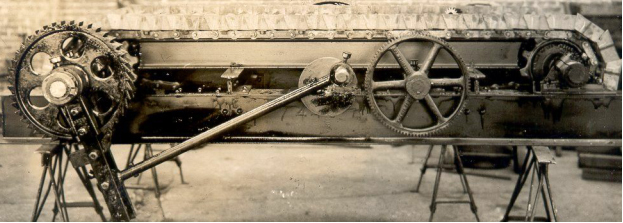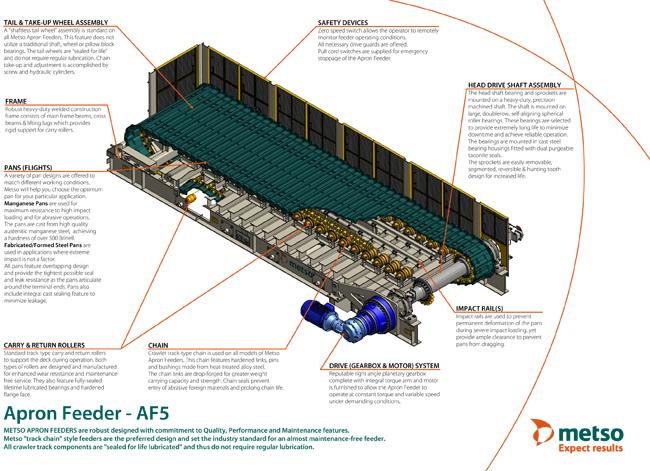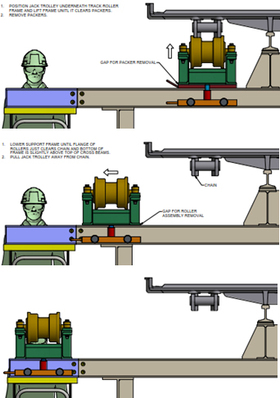Apron feeders are used to transport large, lumpy, abrasive and heavy ores under severe impact conditions - including wet, sticky or frozen operations. With 37 years in the mining industry including 24 years at Metso, Product Specialist Thomas Thomas draws upon his experience to share some insights into apron feeders, and their applications within the minerals processing industry.
Q: Could you give us a bit of general background about the apron feeder?
Apron feeders are robust machines that are designed for long-term use in a diversified range of industrial applications. Their primary function is to extract or feed material short distances at a controlled rate of speed, which prevents choking of material that feeds crushers and other equipment. Apron feeders are also commonly used to reclaim material at a uniform rate from hoppers, vaults, bins, and stockpiles.
Apron feeder design has evolved over time to meet changing industry requirements and address common problems that operators face. Metso has 150 years of engineering knowhow, including 125 years of experience in apron feeder design and manufacture. Throughout this time, we have built a global install base of over 2000 feeders. I would say in the last 20 to 25 years, the design has seen a quantum shift. The apron feeder has become so reliable and user-friendly that it generally needs very little maintenance and is now widely available to suit most applications.

Figure 2: An apron feeder from the past
Q: How has the apron feeder design changed over the past 20 to 25 years?
Machine design characteristics have evolved over time, and many improvements have been introduced to reduce the need for routine servicing. Apron feeders were traditionally designed with many components that required constant lubrication and maintenance. Cast, and forged apron feeder chains are an example of this. Traditional chain designs that required regular lubrication have given way to Sealed and Lubricated (SALT) units, which do not require any lubrication throughout the life of the unit. SALT designs for other components such as rollers and tractor-type tail wheels have also been incorporated in Metso apron feeders. These design improvements ultimately make things easier for operators by increasing machine reliability and therefore reduce the need for day-to-day maintenance.
Machine designs have also evolved to improve operator safety. One such example relates to apron feeder pans, which are also referred to as flights. Pans are high impact, abrasion-resistant wear parts responsible for extracting material and discharging it from the feeder. These components need to be stopped and secured during periods of routine maintenance. As you can imagine, if the pans move while workers are on the machine, it's like having a rug pulled from under you - it poses a significant risk to worker safety. We have developed a locking mechanism for Metso feeders to address this issue. When the locking mechanism is engaged, a pin made from high-tensile steel secures the chain and prevents it from moving in any direction. To further improve safety, a limit switch or proximity sensor is incorporated to indicate pin disengagement via an audio or visual alarm.

Figure 3: Features of a modern apron feeder
Q: What are the main challenges being faced in the current operating environment with respect to apron feeders?
One of the big challenges for the industry is increased pressure to reduce CAPEX costs. Producers are faced with a tough choice, and sometimes opt for a cheaper machine that is satisfactory for current operating parameters but does not have the capability to reach future production targets. In my opinion, it's better to opt for a design that is future-proofed, rather than purchasing the cheapest machine available. This allows greater flexibility in the long-term, and you will avoid the need to replace or retrofit a larger machine into the existing footprint, which can be a costly exercise.
Q: What would you recommend operators do to maximise the availability and reliability of the machine?
This type of machine doesn't require a huge amount of maintenance. Apron feeders are generally very reliable and will just keep working. Having said that, monthly checks are always a good idea to make sure the bolts aren't loose on the pans. It is also good practice to maintain the correct chain tension. This only requires a brief inspection but is important to guarantee smooth operation and longer component life.
It is common for operators to overlook simple tasks like checking the clearance between the pans and skirts. An apron feeder can suffer premature wear if the recommended clearance between these components exceeds 13mm. Larger clearances also increase the risk of bigger lumps of hard ore getting wedged into the gap. In some cases, this may cause the machine to stall, however it is also possible for a machine to fail catastrophically at its weakest point. I have seen this first hand, and it presents a major threat, not only to equipment but also to worker safety.
Q: Can you tell us about any recent safety innovations?
|
An innovation that has been incorporated into Metso apron feeders eliminates the need to lift heavy rollers manually when servicing the machine. Rollers sit underneath the apron feeder pans and chains. Changing them out is difficult due to their weight - even smaller rollers are too heavy for manual lifting. To address this concern, we developed a tool that helps make the job safer and easier. The tool has been designed to allow operators to remove and replace rollers without the need for lifting equipment. This is much safer and eliminates a lot of the manual work that was previously required.
|
|
Q: Where do you see apron feeder technology going in the future?
I think the future is very exciting for apron feeders, with many technological improvements on the horizon. Personally, I believe smart technology will provide operators the capability to optimize their feeders with production requirements in real time. This technology will also provide operators with the ability to accurately forecast maintenance requirements and avoid un-planned downtime.
Replacing apron feeder components can be a costly process, which is often a result of the machines location in a plant. Access can be difficult which makes servicing components an extensive exercise for many operators. There is certainly an opportunity to design feeders in such a way to synchronize the life of key componentry and the associated changeouts. By changing out key componentry at the same time, total maintenance costs can be drastically reduced over the life of the machine.
Metso is a world-leading industrial company offering equipment and services for the sustainable processing and flow of natural resources in the mining, aggregates, recycling and process industries. With our unique knowledge and innovative solutions, we help our customers improve their operational efficiency, reduce risks and increase profitability. Metso is listed on the Nasdaq Helsinki in Finland and had sales of about EUR 2.7 billion in 2017. Metso employs over 12,000 people in more than 50 countries. metso.com, twitter.com/metsogroup
For further information, please contact:
Colin Spann, Vice President Mining Equipment, Australian Market Areas, Metso, Tel. +61 8 9420 5852, Email: colin.spann@metso.com
ABOUT THIS COMPANY
Metso
Metso is a frontrunner in sustainable technologies, end-to-end solutions and services for the aggregates, minerals processing and metals refining industries globally. We improve our customers’ energy and water efficiency, increase their productivity, and reduce environmental risks with our product and service expertise. We are the partner for positive change.
Headquartered in Espoo, Finland, Metso employs over 17,000 people in close to 50 countries; sales for 2023 were about EUR 5.4 billion. The company is listed on the Nasdaq Helsinki.mogroup.com, twitter.com/metsooutotec.
PERTH OFFICE:
- Level 2, 1110 Hay Street, West Perth, WA, 6005, Australia
- Phone: 894205555
- Web: www.metso.com


























